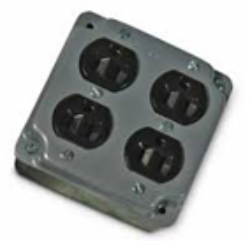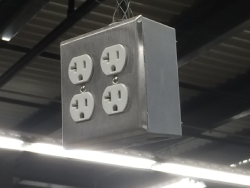Electrical Safety
Electricity is the engine of productivity. It is what allows us to live a modern life and run production equipment, computers, and light our homes and businesses. As valuable as electricity is, it needs to be treated with respect as it can lead to serious injuries including fatalities. There are four main types of electrical injuries:
- Electrocution (fatal)
- Electric shock
- Burns
- Falls caused because of contact with electrical energy
It is for this reason that OSHA regulates the use of extension cords in your facility. The Agency’s standards (29 CFR 1910.301-.399) covers electrical safety requirements in the workplace. The most used electrical equipment found in your facility that is covered under this standard and receive the greatest number of citations are breaker boxes, flexible cords, pendant drops, receptacles, power strips, Ground Fault Circuit Interrupters (GFCIs), and extension cords.
With all electrical equipment, it is important to be knowledgeable of the intended purpose and approved usages. Typically, this information is listed in the manual the equipment comes with. However, if you, like most people, discard of the owner’s manual at first glance, this information can likely be found in the UL (Underwriter’s Laboratory) Standard’s Catalog or UL White Book. Let us look at the requirements and best practices for the common equipment listed above so you can stay in compliance and avoid citations.
Electrical Panels (Breaker Boxes)
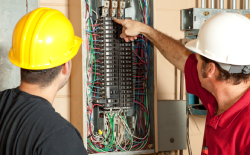 OSHA requires sufficient access and working spaces around all electrical equipment, or panels, serving 600 volts or less. Electrical panels must have a minimum of three feet of clearance in front of the panel and a minimum clearance width of 2.5
feet or the width of the equipment, whichever is greater.
OSHA requires sufficient access and working spaces around all electrical equipment, or panels, serving 600 volts or less. Electrical panels must have a minimum of three feet of clearance in front of the panel and a minimum clearance width of 2.5
feet or the width of the equipment, whichever is greater.
Electrical panels must have an area without live parts exposed to a person on the operating side of the equipment, also known as a dead front. Dead fronts prohibit employees from inadvertently contacting energized components inside the access panel box. All live components must be covered in this way so that anyone using the circuit breaker is safe from electrical shock.
Electrical panels should also have secure covers to ensure no wires are exposed that could cause electrical shock. This also prevents the internal mechanisms from being exposed to dust, dirt, and moisture. Covers should always be closed unless the panel is directly in use. Lastly, each switch must be properly labeled.
Flexible Cords
Because they are exposed, flexible, and unsecured, flexible cords are more susceptible to damage than fixed wiring is. Hazards are 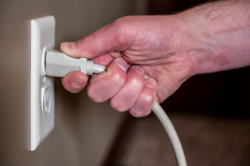 created when cords, cord connectors, receptacles, and cord-and-plug-connected equipment are improperly used and maintained. Here are a few tips
to consider when using flexible cords:
created when cords, cord connectors, receptacles, and cord-and-plug-connected equipment are improperly used and maintained. Here are a few tips
to consider when using flexible cords:
- Avoid tension at cord joints and terminal screws. Strain on the cord can cause the strands of one conductor to loosen from under terminal screws and touch another conductor.
- Do not use a cord that is damaged. Either replace it or get it repaired by a certified electrician.
- Use watertight or sealable connectors in damp or wet areas to avoid getting the cord connector wet.
- Keep cords away from heat and water.
- Remove cords from receptables by pulling on the plug, not the cord itself.
- Do not patch damaged cords yourself—replace them with new ones or get help from a certified electrician to prevent fire hazard.
- Do not affix cords to walls or ceilings using metal nails or staples—to prevent cord jacket from being damaged.
- Do not dangle cords from the ceiling, a doorway, etc.
- Do not run extension cords through doorways—to prevent a trip hazard.
- Do not run cords under rugs or floor mats—abrasion can damage them.
- Do not tamper with plugs. Never break off the third (ground) prong to fit a plug into a two-plug outlet; instead, replace the outlet. If the third prong is removed, the equipment is no longer grounded. Any cord with a prong missing should be put out of service.
Flexible Cords for Powering Equipment
Many pieces of production and other support equipment are powered by flexible cords that are attached to the equipment. The concern with flexible cords is that they are more vulnerable to damage than the fixed wiring of the building. Therefore, they are not allowed to be used as a permanent wiring approach.
OSHA’s standard lists specific situations in which flexible cords may be used and they are:
- Pendants such as a lamp holder or cord-connector body suspended by a length of cord properly secured and terminated directly above the suspended device.
- Wiring of fixtures.
- Connection of portable lamps or appliances.
- Elevator cables.
- Wiring of cranes and hoists where flexibility is necessary.
- Connection of stationary equipment to facilitate their frequent interchange.
- Prevention of the transmission of noise or vibration. In some cases, vibration might fatigue fixed wiring and result in a situation more hazardous than flexible cord.
- Appliances where the fastening means and mechanical connections are designed to permit removal for maintenance and repair (e.g. water coolers, exhaust fans).
- Data processing cables approved as a part of the data processing system.
Unless specifically permitted by one of the above situations, where flexibility is required, flexible cords and cables may not:
- Be used as a substitute for the fixed wiring of the structure.
- Run through holes in walls, ceilings, or floors.
- Run through or above doorways, windows, or similar openings.
- Attached to building surfaces such as pipes, walls, ceilings, racking, etc.
- Concealed behind building walls, ceilings, or floors.
- Under rugs or floor mats – abrasion can damage them.
Pendant Drops
Pendant drops are receptacle boxes suspended with a cord from a junction box. They are used for portable power sources such as multiple pieces of equipment in a printing operation that get moved frequently. There are several specifications that must be adhered to for safe utilization of this equipment.
Acceptable Receptacle Box for Pendant Drop | Unacceptable Receptacle Box for Pendant Drop |
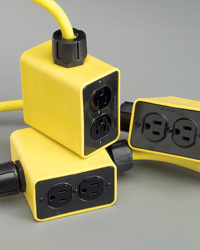 |
|
- Only specific types of receptacle boxes are permitted to be hung from a pendant drop.
- Receptacle boxes with knockouts (e.g., metal, or plastic tabs that can be easily removed) that are designed to be mounted to a wall are not allowed to be hung from a pendant drop.
- Boxes must be solid and closed without knockouts on the sides.
- A strain relief must be present at the point where the wire originates and at the wire’s entrance into the receptacle box.
- Failure to maintain these strain relief points is a fire hazard.
- Tension relief must also be provided where the cable enters the box. In some types of boxes, this is incorporated into the box’s design and for others it must be added. Note the device on top of the hanging box.
- The cable used must be rated and labeled for use as a pendant drop.
- The circuit must be capable of withstanding the load from the equipment.
- Receptacle boxes may never rest on the floor.
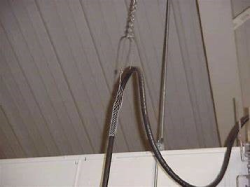 |
|
Receptacles
Switch plates and receptacle covers are designed to prevent people from encountering the live electrical parts inside the switch/receptacle box. Wall mounted receptacles as well as standard metallic receptacle outlet boxes are most often used in manufacturing facilities. Wall mounted receptacles should be checked and maintained. It is a best practice to check each outlet monthly to ensure proper electricity flow, there are no visible signs of damage to the conduit and cord providing power supply, the box is mounted and undamaged, the receptacle, if present, is not damaged, and a cover plate is in place and not damaged.
Power Strips
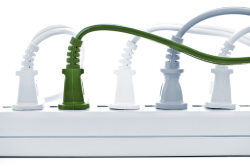 Power strips, or “relocatable power tabs” as OSHA refers to them, are often misused. Be careful to only use power strips for their intended purposes, which are to provide protection for equipment that does not draw large amounts of electricity
from power surges, shorts, etc. Failing to use them correctly is could be a fire hazard and result in injury.
Power strips, or “relocatable power tabs” as OSHA refers to them, are often misused. Be careful to only use power strips for their intended purposes, which are to provide protection for equipment that does not draw large amounts of electricity
from power surges, shorts, etc. Failing to use them correctly is could be a fire hazard and result in injury.
- Power strips are only intended for indoor use—outdoor use is ill advised.
- Only connect power strips to a permanently installed branch-circuit receptacle outlet. Do not connect them to other power strips or extension cords.
- Do not permanently secure a power strip to building structures, tables, work benches, etc.
- Do not substitute power strips for fixed wiring.
- Only use power strips to energize small appliances or tools and do not overload a power strip’s capability. Typical power strips are rated for 10-20 amps or less. They are not intended to connect to production equipment or appliances with large energy demand such as microwaves, heaters, refrigerators, etc.
Ground Fault Circuit Interrupters
A GFCI is a device that interrupts the electric circuit to load when a fault current to ground exceeds some predetermined value, that is less than that required to operate the over-current protective device of the supply circuit. It protects the user of an electrically powered tool or system from serious injury or death in case a ground-fault, or a break in the grounding path, occurs. GFCIs are designed to shut off electric power within as little as 1/40 of a second after sensing the fault.
These safety devices can be incorporated into special outlets, included as part of a power cord, or placed in-line to continually monitor the current passing through a receptacle. GFCI’s are required in kitchens, bathrooms, garages and any electrical outlet that is or could be at any time within six feet of a source of water. Learn more about GFCIs and electrical incidents on OSHA’s webpage.
Extension Cords
Electrical accidents when using cords can be prevented through proper maintenance and the following best practices. Remember, 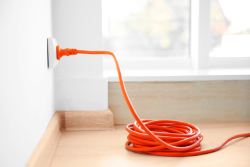 extension cords are for temporary use only. Using them as a permanent wiring solution is an OSHA and fire code violation.
extension cords are for temporary use only. Using them as a permanent wiring solution is an OSHA and fire code violation.
- Extension cords cannot be used to power any production, computer, printer, other equipment, or a power strip on an on-going basis.
- Only use extension cords that are 3-wire type and designated with the code for hard or extra hard usage.
- Use Ground Fault Circuit Interrupters (GFCI’s)—to automatically disconnect power in a damp or wet area if a dangerous situation arises and to avoid overloading circuits.
- Check cords for damage before use.
- Make sure the cord is completely plugged into an outlet.
- Refrain from plugging one extension cord into another—to prevent fire hazard.
- Do not patch damaged cords yourself—replace them with new ones.
- Unplug extension cords when not in use and store the cords indoors.
Training to Recognize Electrical Hazards
As with all safety practices, it is important that you ensure that all employees are aware of best practices when using flexible cords, power strips, and extension cords. Encourage all employees to fix or report malpractices or damages immediately to prevent potential incidents or injuries.
Ensure qualified employees are trained on how to handle minor fixes on an electric panel, how to lockout out the panel, and affected employees are well versed in best management practices of a panel—including appropriate PPE and encourage them to report any malpractices or mishaps that may occur.
Review OSHA’s Hazard Recognition resource as a tool to become familiar with potential electrical hazards than may occur.
PRINTING United Alliance’s OSHA Compliance Resource Center provides technical assistance and services designed to allow printing operations to manage compliance and stay informed. For more information on Electrical Safety or PRINTING United Alliance’s EHS services, email govtaffairs@printing.org or call 888-385-3588
